The Clothesline Method

I’m just starting a new novel, trying to figure out the shape of the damn thing. Here’s a trick I use that might help you too. I call it the Clothesline Method.
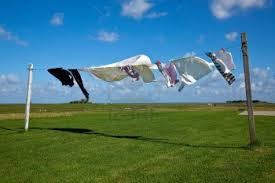
All you need is some clothes pins and your imagination
I think of the story as an old-fashioned clothesline, like people used to string up in their back yards to hang the laundry on. The left-hand end is the beginning of the story. The right-hand terminus is the end.
The line starts out empty.
Then you hang the shirts and towels and underwear (the scenes and sequences) on it.
I aim for between eight and twelve.
Sometimes I’ll actually draw a clothesline on a piece of paper (yellow foolscap, my fave) and sketch in a dozen or so squares hanging beneath.
What I love about this method is it’s simple and it’s dumb. It takes all the preciousness out of the process. And it eliminates a lot of the fear. How hard is it to hang a dozen dresses, sheets, and pairs of blue jeans on a line?
You can start with just one. Say you know the ending. Great. Hang that on the right-hand end of the line.
Maybe you’ve got one killer scene or sequence that you know goes somewhere in Act Two. Beautiful. Hang that in the middle of the line.
Let’s say you don’t know the beginning. No worries. Just pin a place-holder, however vague, to the left-hand side of the line.
Now you’ve actually got something.
I feel better already, just thinking about it.
The other great thing about the Clothesline Method is it identifies the gaps and forces you to fill them.
Sit still and stare at that gaping chasm between the killer scene in the middle and the final scene at the end. What’s missing? Trust me, you’ll come up with something. Sometimes just staring at that gap and applying common sense is all you need.
As an example, let’s take my favorite movie of the past couple of years, David O. Russell’s Silver Linings Playbook from the novel by Matthew Quick. Haven’t seen it? How can that be? It’s on at least four cable channels every night. I just watched it for the fifteenth time last night.
Okay. Be that as it may …
Let’s imagine we’re writing the original novel (or the movie as if it evolved from scratch). We know the climax, let’s assume, will be the dance contest and the wrap-up where Pat (Bradley Cooper) and Tiffany (Jennifer Lawrence) finally get together for keeps. That’s the bedsheet that we’ve hung at the far right-hand end of our Clothesline.
Let’s say too that we know the opening. Pat gets out of the mental hospital in Baltimore and returns to the home of his parents (Robert DeNiro and Jacki Weaver) in Philadelphia, determined to reconcile with his estranged wife, Nikki. Hang that at the left-hand end of the Clothesline.
See how the gaps start to fill themselves?
Clearly we need a scene, early on, where Pat meets Tiffany—and where we, the audience, sense these two are meant for each other.
Clearly we need some scene or sequence that gets them together to begin practicing for the dance contest.
Clearly we need several freak-out scenes along the way where Pat and Tiffany clash, inevitably over Pat’s obsession with Nikki, and nearly blow up their charming, true-love, nicely-evolving relationship.
Shirt, towel, dress, blue jeans.
As we hang each scene/sequence on the Clothesline, the gaps tell us where we need other set-ups, other twists, other turns in the story.
The Clothesline Method is a bit like the Foolscap Method, except it doesn’t worry about genre or theme or point of view or narrative device. It focuses entirely on actual scenes and sequences. It answers the question, “What happens?”
Like the Foolscap Method, the Clothesline Method’s great strength is it gives us confidence. By the time we’ve got six or seven scenes/sequences hung on the line, we’re beginning to really see the story. Yeah, we may be missing a few transitions and a handful of dramatic moments, but we can see the contour of the narrative. We can see that it’ll work.This is HUGE, as it fortifies us for the thousands of moments along the way when Resistance will rear its ugly head and tell us we’re losers, our story sucks, trash the whole stinkin’ mess.
It’s very helpful too, at least to me, that the Clothesline device is visual. It’s not just words on pages. It’s a graphic. It’s a schematic. We can see the whole thing at one glance.
As anyone who reads this blog knows, I’m a big believer in the Muse (or the Unconscious.) The gaps in the Clothesline, I believe, are prime fodder for the goddess. When she sees them, she goes to work. Next morning in the shower, an idea pops into our heads for filling the vacant space between the bath towel near the end of the clothesline and the pair of Oshkosh overalls in the middle.
And here’s the last, best part of the Clothesline Method: it’s free.
You don’t have to take a seminar. You don’t have to hire an expert. You don’t even need to read a book.
All you need is two imaginary hooks and one make-believe piece of line.
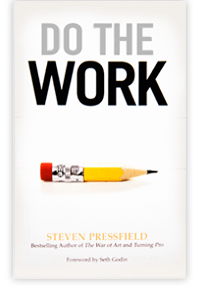
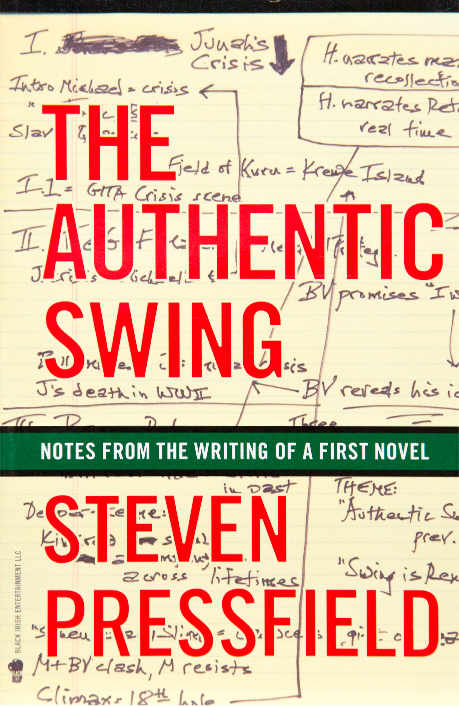
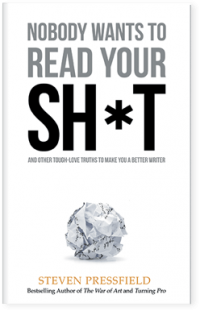
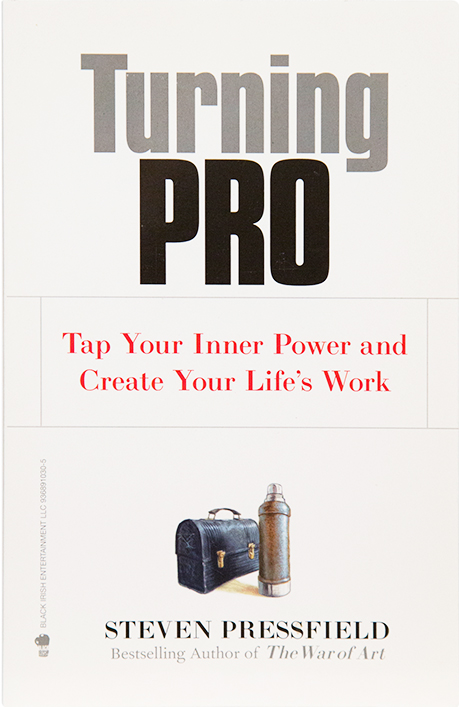
By the end of this post, I thought, I have a book in me, I just need to write it down. Great Job, Steve.
Thank You for sharing this.
It’s a very helpful visual – thanks for keeping it simple!
Please keep them coming.
Your explanation of resistance is magnificent. I ran a personal best today because I now know that resistance is “faster than a speeding bullet”.
Thanks mate
I love the simplicity of this kind of outline! I’m more of a pantser than a detailed planner but I still like to know which direction I am going. I’m going to try this method as it just might work for me.
Steven . . . the writer Anne Lamott goes you one better! I attended one of her keynote speeches to a writers group and she discussed the clothesline method she uses. She uses a real clothesline and real clothespins in her office. When starting on a project she hangs up the line stretched between two walls and starts hanging notes on it as she works a project. I love this idea!
Ah, that Anne Lamott. Who knew? She is way, way ahead of me!
Would using the clothesline method HELP when writing a TRUE story?
Gwen, a “true” story is first and foremost a story.
For anyone to care, you’re going to have to ensure that what you put in and what you take out fits on the clothesline exactly as it would with pure fiction.
“That’s what really happened!” has nothing to do with storytelling. Even a business book does better when it includes all the elements of a great novel.
Thanks so much, Joel.
Amen to that, Joel and Gwen.
It also depends on the format.
In journalism, the goal is to get right to the point and, in the very first paragraph, tell the reader what happened in the simplest terms while including only the most relevant details.
Then you circle back and tell the reader how or why it happened, thus the inverted pyramid.
Storytelling is obviously different, and I think a good example is the TV “news magazines” like 20/20 where they structure a true crime story like a book or TV show, holding back key details from the viewer until the very end.
Either way, you’ve gotta find a hook to reel ’em in from the start, which is why I’m a big fan of in media res. A good example from Steve’s catalog is the Afghan campaign, which opens with an exciting scene late in the narrative, then jumps back to the beginning to show the reader how it got to that point.
The clothesline works for in media res too, and it’s as simple as taking a towel or pair of pants and moving it from the middle to the beginning. I also find it useful when I’m stuck or feel pressure writing a suitable beginning — I just jump forward and write another scene, like a director filming out of order, and once I’m in the groove I have a better idea of what the beginning should look like.
As someone who struggles with plot quite often, I appreciate the clothesline metaphor. Thanks Steve.
i value everything that comes from this site, but today’s posting has to be the best (for me). my first(!!) book came out recently and i realize, in hindsight, that this is what i did — a clothesline approach. i just kept writing 575-word segments (i.e., weekly columns) to my story and banked on being able to connect them later. which i did. so today’s posting helps to validate my processes. i didn’t actually do the following, but: it felt to me like i placed 100+ 575-word segments on the floor, and moved them around until they represented my story — until they connected in a somewhat cohesive way. thanks again for this steven. i find the best education i get, comes when i need to validate the methods i intuitively gravitate to. today you gave me that validation.
Steve, this is the same or similar to the storyboard method that visual artists use. I first learned to create storyboards when I took my first children’s book class. It is basically drawing a series of squares that show the sequence of the story visually. It is usually reworked several times in the course of creating a book, and can be worked exactly like you work your clothesline. It is also widely used in comics, advertising, and animation.
I agree it is a most helpful way to work, a way to “see” an entire work of art at once, a way of filling in gaps and not overthinking the process.
Very informative, Steve. Love the metaphor.
I wonder if you have read The Silver Linings Playbook novel. It is heartwrenchingly authentic.
Thanks for a great metaphor and tool! I appreciate the way the clothesline takes the preciousness (as you put it) out of the process.
It’s not a Big Deal — you’re just hanging something on the clothesline. Because it’s not a big deal, we’re able to play without anxiety (which my research shows fuels resistance).
If it turns out something you put on the clothesline doesn’t fit, you can always move to a different spot on the line or take it off the line and into the “laundry basket” for awhile. You’re not deleting (which can feel like a Big Deal), you’re just seeing what the line looks like without that pair of overalls.
I also appreciate Anne Lamont’s literal clothesline (as Janet Wentworth mentioned in her comment) because it’s easier to move around pieces of paper on an actual line than to change what’s written on a single piece of paper. The rearranging part is an important part of the process for me — what happens if I move this scene with this POV character here instead of there?
Rosanne, I’m already picturing colorful 3×5 cards on a miniature clothesline in my writing office. (Blue, carefully trimmed, for those Oshkosh B’Gosh overalls I don’t own anymore.)
Great discussion! I use the clothesline method when writing narrative or developing a course or presentation. In powerpoint, you can choose the Slide Sorter view and “presto” you have your clothesline, where you can easily drag and drop your slides – or content chunks – in to different orders. I am a mindfulness and leadership coach, and I want to thank you Roseanne for bringing in the reality of resistance – and how the clothesline and laundry basket can be a great strategy for moving through the stuck places.
I love this simple approach, gonna test it out on my writing.
A main reason I’m guessing it works is: before you even start hanging stuff on it, you already have a physical “object” built! In essence you’ve already manufactured something that did not exist before, you’re already creating, and for a writer that’s a big momentum boost.
Best of luck on foolscapping that new jammie!
Always good stuff here. Like sitting across the table, getting it over a cup of java. Appreciated.
A life-saving hint! Thank you!
I love this! Gives one the flexibility of jotting down all the scenes and moving them around as necessary. Thanks!
Thanks for the reminder that The Muse is there with me, working behind the scenes.
Steve– Great post. It is a solution to a challenge I imagine we all have to conquer eventually.
I’m a software architect who often manages development projects. When I overcame some resistance and started writing stories, I naturally turned to some of the tools I use designing and managing software. I use a Microsoft Office product called Visio all the time. It is a multipurpose tool, but one application is to manage timelines. Like a clothes line, you pin tasks (scenes) on the timeline to work out the order and timing. Unlike a clothes line, when you move a task, the duration of the tasks (scenes) stay the same, but all the other dates and times adjust. If you decide to move a scene, it shows you how you must change dates to accommodate the change. Until I thought of using Visio, these adjustments consumed much more time and energy than I wanted to give them.
Viseo is pricy, and this is just one function– it also draws hundreds of different specialized diagrams used in software architecture– so I would think twice about buying it just to manage timelines, but it is a great tool if you have it.
This is my first time visiting your webpage and I am very impressed with your content I recently started learning the art/craft of writing after a ten year hiatus. I’m continuously learning new resources to help me on my way. I have a pretty large collection that grows daily. I will add yours to the pile because I think it is important to the craft. Thank you!
I recently started learning the art/craft of writing after a ten year hiatus. I’m continuously learning new resources to help me on my way. I have a pretty large collection that grows daily. I will add yours to the pile because I think it is important to the craft. Thank you!
Love it! Sharing it!
I love this! Can’t wait to try it on a set of lectures I’m planning, as well as on a troubling non-fiction book chapter.
This sounds to me like a joyful, manageable version of storyboarding. The advantage of a clothesline is it has to fit in my back yard. Very finite. Just one load of wash. Storyboards seem to be infinitely expandable adding to the complication of the process.
Thanks tons.
This method is what is known as a through line. Your method does not account for subplots (second, third, or more clotheslines). Still, it is a nice visual for through lines.
WoW!!! Irresistible!!!
Thanks to Doug Neil for showing this method. Thanks, Steven for such a wonderful method! Writing Wednesdays, I m hooked to you!!
Sit still and stare at that gaping chasm between the killer scene in the middle and the final scene at the end. What’s missing? Trust me, you’ll come up with something. Sometimes just staring at that gap and applying common sense is all you need.
hoodies til mænd
The “Clothesline Method” is a simple yet effective approach to organizing your wardrobe. It involves laying out your clothing items on a clothesline or hanging rod in a way that allows you to easily view and access them. This method is often used for displaying outfits, especially for specific occasions like a date night, where choosing the perfect date night dress can be a challenge. By using the clothesline, you get to see all your options at once, making it easier to mix and match pieces or decide which dress might work best for the evening. It’s a possibility that this technique could make the process of outfit selection more enjoyable and less stressful.
This all sounds interesting, but I stumbled on this post because I ruined some really expensive clothes by washing them wrong. After they dried, they were unwearable. I was actually googling how to properly wash and dry clothes to avoid this happening again. I’m so upset; I loved those pieces.
I’m guessing you’re talking about wool clothes that shrink or stretch out of shape after washing? If so, I totally get it—it’s frustrating. I’ve had similar issues and now handle delicate fabrics and specialty materials with extra care. My sister, for example, insists that her best lingerie for women can only be hand-washed to avoid damaging the high-quality fabric or intricate designs. Some pieces really do need that extra attention.
Hello. Clothes play a significant role in our lives, as they help us express our individuality, create comfort for movement, and set ourselves in a certain mood. In the world of dance, this is especially important, because the costume not only emphasizes the aesthetics of movements, but also gives confidence and harmonizes with the creative image. If you’re looking for inspiration for the perfect dance outfit, you should check out Art de Ballet , which offers stylish and high-quality clothing for ballet and other dance styles.
Starting with the broad strokes the Trailtrekker is a 39.5mm steel watch that is 11.8mm thick and 46.6mm lug goedkope bvlgari horloge to lug. With 200 meters of water resistance drilled lugs a sapphire crystal and a solid steel case back it’s a straightforward offering that clearly takes some inspiration from the Rolex perspective on an adventurous watch that can manage two time zones.